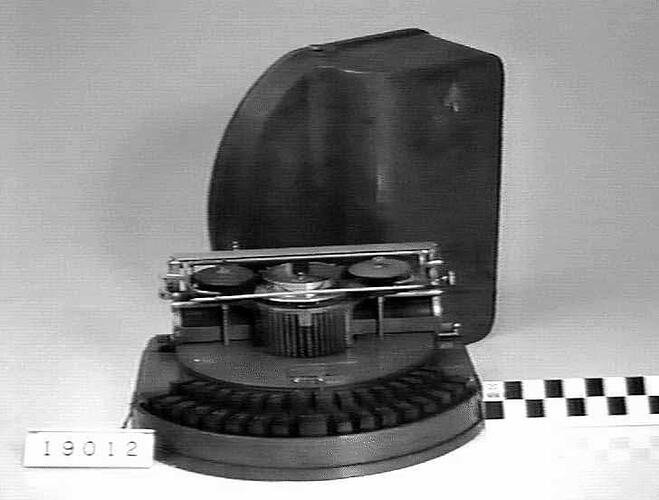Summary
Typewriter of the typewheel class manufactured by the Hammond Typewriter Company of New York, USA. The design was invented by Jame Bartlett Hammond and was first patented in 1880. The Model No. 1 came on the market in 1884.
In this typewriter the characters are carried on a curved strip or shuttle which is attached to a swinging wheel. Pressing a key rotates the wheel and shuttle to bring the selected character into position opposite a hammer. The spring-driven hammer then strikes the paper against the character and ribbon. Because the printed impression of each character was controlled by the hammer spring and not by the force with which the operator struck the key the Hammond typewriters had the reputation of producing very even looking print.
Different shuttles were available, allowing changes in fonts and languages. In some models two shuttles could be attached to the typewheel at the same time so that fonts could be changed simply by rotating the typewheel through 180 degrees on its spindle. Hammond typewriters were available with either a curved keyboard (known as the 'Ideal') as with this machine, or a straight keyboard (known as the 'Universal').
Physical Description
Wooden base. Semicircular keyboard with keys, possibly of ebonite. Type ribbon carried between spools on vertical axes. Sector typewheel rotates within metal sleeve. One sector of typewheel has been broken off. Wooden cover fits over typewriter.
More Information
-
Collecting Areas
-
Acquisition Information
Purchase
-
Manufacturer
Hammond Typewriter Company, New York, New York State, United States of America, circa 1894
-
Inscriptions
Plate on wooden panel above keyboard engraved: "THE / HAMMOND / TYPEWRITER Co. N.Y. / PAT'D/ [List of prior patents and dates] DEC 18 1883"
-
Classification
-
Category
-
Discipline
-
Type of item
-
Overall Dimensions
370 mm (Width), 300 mm (Depth), 175 mm (Height)
DImensions of typewriter without case or lid.
-
Overall Dimensions
370 mm (Width), 315 mm (Depth), 180 mm (Height)
Dimensions of typewriter with case or lid on.
-
Other Dimensions
355 mm (Width), 315 mm (Depth), 237 mm (Height)
Dimensions of typewriter body only, with paper guide up.
-
References
REFERENCE- MARES, G. C., HISTORY OF TYPEWRITERS (INCLUDING ILLUSTRATIONS), AND ADLER, MICHAEL H., THE WRITING MACHINE.
-
Keywords
